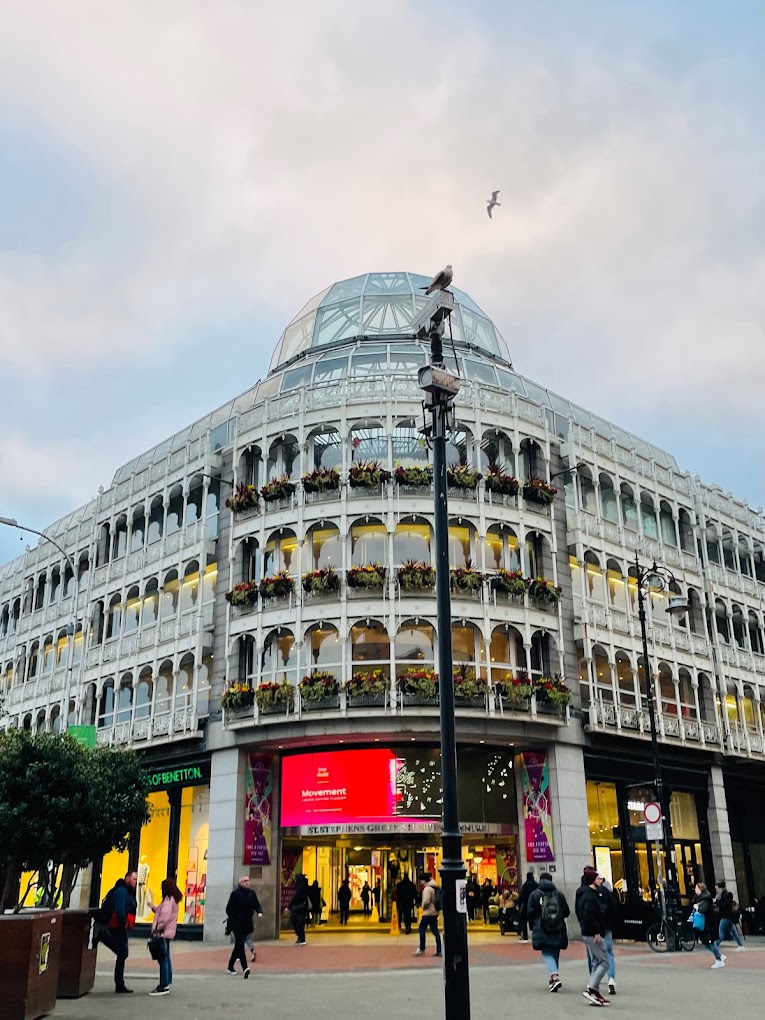I was reminded when reading Una Mullally’s piece on the proposal to demolish the Stephen’s Green Shopping Centre at the top of Grafton Street and to replace it with a rather dull, monolithic building of the controversy which accompanied the present centre’s construction in the first place.
It replaced a diverse set of buildings on St Stephen’s Green and South King Street which included the Green Cinema, the famous Mays music shop, and two very trendy watering holes, Rice’s pub and Bartley Dunne. None of them had any particular architectural significance, but collectively they amounted to a corner of old Dublin.
Indeed, Frank McDonald, the champion of urban conservation to whom Mullally turned for supportive comment in her piece, was originally somewhat underwhelmed by the appearance of the present centre which he likened to that of an enormous Mississippi steamboat. The centre’s cladding of decorative ironwork divided opinion at the time.
I always liked the ironwork balustrade-like cladding but felt, and still feel, that the centre’s iconic glass dome was a bit angular and done on the cheap. The centre’s upper floors need re-thinking.
But Irish and, indeed, European architectural orthodoxy has dictated that form is decided by function and frowns on mere decoration in the external appearance of modern buildings. Perhaps high points of such orthodoxy were the Rogers-designed Pompidou centre in Paris and the Lloyds building in London.
If you want an example of precisely the opposite viewpoint in architecture, you need look no further than the Bank of Ireland’s old Parliament House on College Green. Its magnificent classical colonnades and pedimented porticos are revealed by aerial photography to be an exercise in facadism bearing little or no relationship to the brick buildings which they so perfectly conceal.
For my part, I am fond of architectural decoration – internal or external. I feel somewhat oppressed by architectural purists who seem to despise any reversion to older architectural styles as pastiche. Just as we treasure internal plasterwork by the Francini brothers or by Stapelton, I value coherent and elegant external facades of Georgian, Victorian and Edwardian architecture – even when they exhibit a considerable degree of decoration and whimsy.
Over Christmas, I was delighted to find a posthumous portrait of lost Dublin architecture by the great architectural historian, Niall McCullough, who sadly died in 2021. His “Dublin – Creation Occupation Destruction” deserves to be owned and read by all who love and cherish our capital city. While nearly all of what he records is vanished or threatened and cannot be recovered, the fact that Dublin was once a city with a distinctive vernacular architecture of its own must challenge us to query what is happening to that city today.
We speak of city planners. But is there really a plan? Or is it not the case that there is no plan in a positive sense but merely a system of incoherent development permits, zoning and guidelines that provide no coherent outcomes – all based on the fanciful and discredited notion that laissez faire developers on accidentally aggregated sites will build for us a beautiful city?
None of what most people would consider the more beautiful parts of historic Dublin emerged from such a haphazard process. And we have no reason to confidently expect that anything of beauty will be built in terms of appearance or streetscape if we allow the current methods of urban development to persist.
In truth, if Dublin is to become a liveable thriving urban community rather than an extended crime scene, we need vision and the means to make that vision a reality.
For example, if city centre apartments are to be combined with retail and other activities in buildings to be constructed, we need to plan for and drive a construction process for five- to seven-storey apartment blocks with other street-level uses in our city centres.
We need, like Haussman’s Paris, to devise new urban vernaculars. And we need to use powers of compulsory purchase to achieve such outcomes. We need to use building leases on publicly assembled sites to achieve what the Gardiner estate and Pembroke estate achieved two centuries ago. None of this will happen by itself. The market, by itself, does not build beautifully or coherently.
Yes, we have had apartment complexes built by private developers in recent years. A good deal of it replaced obsolete buildings in the wake of road widening schemes. Yes, there were some few efforts to build inner city social and affordable housing. But those efforts were half-hearted if well intentioned.
The sad truth is that we simply do not have urban planning anywhere in Ireland.
I recently met a very experienced and very committed city councillor and in the course of conversation the issue of a compulsory purchase came up. I was told: “Michael, you know that compulsory purchase in Dublin takes 15 years.” That says an awful lot.

